Seasonality of Biophysical Parameters in Extreme Years of Precipitation in Pernambuco: Relations, Regionalities, and Variability
Abstract
:1. Introduction
2. Materials and Methods
2.1. Area of Study
2.2. Database
2.2.1. Precipitation in the State of Pernambuco
2.2.2. Remote Sensing Products
2.3. Statistical Analysis
2.4. Spatial–Temporal Seasonality of Biophysical Parameters
3. Results and Discussion
3.1. Seasonality of Biophysical Parameters in Extreme Years—Pernambuco (State Level)
3.2. Seasonality of Biophysical Parameters in Extreme Years—Homogeneous Precipitation Zones of Pernambuco
3.3. Spatial Variability of Biophysical Parameters in Pernambuco
4. Conclusions
Author Contributions
Funding
Institutional Review Board Statement
Informed Consent Statement
Data Availability Statement
Acknowledgments
Conflicts of Interest
References
- Marengo, J.A.; Cunha, A.P.M.A.; Nobre, C.A.; Ribeiro Neto, G.G.; Magalhaes, A.R.; Torres, R.R.; Sampaio, G.; Alexandre, F.; Alves, L.M.; Cuartas, L.A.; et al. Assessing Drought in the Drylands of Northeast Brazil under Regional Warming Exceeding 4 °C. Nat. Hazards 2020, 103, 2589–2611. [Google Scholar] [CrossRef]
- Costa, R.L.; Macedo de Mello Baptista, G.; Gomes, H.B.; Daniel dos Santos Silva, F.; Lins da Rocha Júnior, R.; de Araújo Salvador, M.; Herdies, D.L. Analysis of Climate Extremes Indices over Northeast Brazil from 1961 to 2014. Weather Clim. Extrem. 2020, 28, 100254. [Google Scholar] [CrossRef]
- Mariano, D.A.; dos Santos, C.A.C.; Wardlow, B.D.; Anderson, M.C.; Schiltmeyer, A.V.; Tadesse, T.; Svoboda, M.D. Use of Remote Sensing Indicators to Assess Effects of Drought and Human-Induced Land Degradation on Ecosystem Health in Northeastern Brazil. Remote Sens. Environ. 2018, 213, 129–143. [Google Scholar] [CrossRef]
- Cunha, A.P.M.A.; Tomasella, J.; Ribeiro-Neto, G.G.; Brown, M.; Garcia, S.R.; Brito, S.B.; Carvalho, M.A. Changes in the Spatial–Temporal Patterns of Droughts in the Brazilian Northeast. Atmos. Sci. Lett. 2018, 19, e855. [Google Scholar] [CrossRef]
- Oliveira, P.T.; Santos e Silva, C.M.; Lima, K.C. Climatology and Trend Analysis of Extreme Precipitation in Subregions of Northeast Brazil. Theor. Appl. Climatol. 2017, 130, 77–90. [Google Scholar] [CrossRef]
- Engle, N.L. The Role of Drought Preparedness in Building and Mobilizing Adaptive Capacity in States and Their Community Water Systems. Clim. Change 2013, 118, 291–306. [Google Scholar] [CrossRef]
- Hastenrath, S. Exploring the Climate Problems of Brazil’s Nordeste: A Review. Clim. Chang. 2012, 112, 243–251. [Google Scholar] [CrossRef]
- Marengo Orsini, J.A.; Alves, L.M.; Alvala, R.C.S.; Cunha, A.P.; Brito, S.; Moraes, O.L.L. Climatic Characteristics of the 2010–2016 Drought in the Semiarid Northeast Brazil Region. An. Acad. Bras. Cienc. 2017, 90, 1973–1985. [Google Scholar] [CrossRef]
- Neto, R.M.B.; Santos, C.A.G.; do Nascimento, T.V.M.; da Silva, R.M.; dos Santos, C.A.C. Evaluation of the TRMM Product for Monitoring Drought over Paraíba State, Northeastern Brazil: A Statistical Analysis. Remote Sens. 2020, 12, 2184. [Google Scholar] [CrossRef]
- Brito, S.S.B.; Cunha, A.P.M.A.; Cunningham, C.C.; Alvalá, R.C.; Marengo, J.A.; Carvalho, M.A. Frequency, Duration and Severity of Drought in the Semiarid Northeast Brazil Region. Int. J. Climatol. 2018, 38, 517–529. [Google Scholar] [CrossRef]
- Cunha, A.P.M.; Alvalá, R.C.; Nobre, C.A.; Carvalho, M.A. Monitoring Vegetative Drought Dynamics in the Brazilian Semiarid Region. Agric. For. Meteorol. 2015, 214–215, 494–505. [Google Scholar] [CrossRef]
- Gutiérrez, A.P.A.; Engle, N.L.; De Nys, E.; Molejón, C.; Martins, E.S. Drought Preparedness in Brazil. Weather Clim. Extrem. 2014, 3, 95–106. [Google Scholar] [CrossRef]
- Barbosa, H.A.; Lakshmi Kumar, T.V.; Paredes, F.; Elliott, S.; Ayuga, J.G. Assessment of Caatinga Response to Drought Using Meteosat-SEVIRI Normalized Difference Vegetation Index (2008–2016). ISPRS J. Photogramm. Remote Sens. 2019, 148, 235–252. [Google Scholar] [CrossRef]
- Cunha, A.P.M.A.; Zeri, M.; Leal, K.D.; Costa, L.; Cuartas, L.A.; Marengo, J.A.; Tomasella, J.; Vieira, R.M.; Barbosa, A.A.; Cunningham, C.; et al. Extreme Drought Events over Brazil from 2011 to 2019. Atmosphere 2019, 10, 642. [Google Scholar] [CrossRef]
- Da Rocha Júnior, R.L.; Dos Santos Silva, F.D.; Costa, R.L.; Gomes, H.B.; Pinto, D.D.C.; Herdies, D.L. Bivariate Assessment of Drought Return Periods and Frequency in Brazilian Northeast Using Joint Distribution by Copula Method. Geosciences 2020, 10, 135. [Google Scholar] [CrossRef]
- Bezerra, A.C.; da Silva, J.L.B.; da Silva, J.L.B.; Lopes, P.M.O.; Nascimento, C.R.; Ribeiro, E.P.; Galvíncio, J.D.; da Silva, M.V. Dynamics of Land Cover and Land Use in Pernambuco (Brazil): Spatio-Temporal Variability and Temporal Trends of Biophysical Parameters. Remote Sens. Appl. 2022, 25, 100677. [Google Scholar] [CrossRef]
- Refati, D.C.; da Silva, J.L.B.; Macedo, R.S.; Lima, R.D.C.C.; da Silva, M.V.; Pandorfi, H.; Silva, P.C.; de Oliveira-Júnior, J.F. Influence of Drought and Anthropogenic Pressures on Land Use and Land Cover Change in the Brazilian Semiarid Region. J. S. Am. Earth Sci. 2023, 126, 104362. [Google Scholar] [CrossRef]
- da Silva, J.L.B.; de Albuquerque Moura, G.B.; da Silva, M.V.; de Oliveira-Júnior, J.F.; da Rosa Ferraz, A.M.; Refati, D.C.; da Cunha Correia, L.R.; de Carvalho, A.A.; Ferreira, M.B.; de Brito, J.I.B.; et al. Environmental Degradation of Vegetation Cover and Water Bodies in the Semiarid Region of the Brazilian Northeast via Cloud Geoprocessing Techniques Applied to Orbital Data. J. S. Am. Earth Sci. 2023, 121, 104164. [Google Scholar] [CrossRef]
- Ayanlade, A.; Jeje, O.D.; Nwaezeigwe, J.O.; Orimoogunje, O.O.I.; Olokeogun, O.S. Rainfall Seasonality Effects on Vegetation Greenness in Different Ecological Zones. Environ. Chall. 2021, 4, 100144. [Google Scholar] [CrossRef]
- Houspanossian, J.; Giménez, R.; Jobbágy, E.; Nosetto, M. Surface Albedo Raise in the South American Chaco: Combined Effects of Deforestation and Agricultural Changes. Agric. For. Meteorol. 2017, 232, 118–127. [Google Scholar] [CrossRef]
- Liu, Q.; Liu, Q.; Meng, X.; Zhang, J.; Yao, F.; Zhang, H. The Impact of Seasonality and Response Period on Qualifying the Relationship between Ecosystem Productivity and Climatic Factors over the Eurasian Steppe. Remote Sens. 2021, 13, 3159. [Google Scholar] [CrossRef]
- IPCC Special Report: Global Warming of 1.5 °C; Summary for Policymakers; Intergovernmental Panel on Climate Change: Geneva, Switzerland, 2018; pp. 1–24. [CrossRef]
- da Silva, R.O.B.; Montenegro, S.M.G.L.; de Souza, W.M. Tendências de Mudanças Climáticas Na Precipitação Pluviométrica Nas Bacias Hidrográficas Do Estado de Pernambuco. Eng. Sanit. Ambient. 2017, 22, 579–589. [Google Scholar] [CrossRef]
- Nanzad, L.; Zhang, J.; Tuvdendorj, B.; Nabil, M.; Zhang, S.; Bai, Y. NDVI Anomaly for Drought Monitoring and Its Correlation with Climate Factors over Mongolia from 2000 to 2016. J. Arid Environ. 2019, 164, 69–77. [Google Scholar] [CrossRef]
- Zhang, J.; Okin, G.S.; Zhou, B. Assimilating Optical Satellite Remote Sensing Images and Field Data to Predict Surface Indicators in the Western U.S.: Assessing Error in Satellite Predictions Based on Large Geographical Datasets with the Use of Machine Learning. Remote Sens. Environ. 2019, 233, 111382. [Google Scholar] [CrossRef]
- Costa, G.B.; Mendes, K.R.; Viana, L.B.; Almeida, G.V.; Mutti, P.R.; e Silva, C.M.S.; Bezerra, B.G.; Marques, T.V.; Ferreira, R.R.; Oliveira, C.P.; et al. Seasonal Ecosystem Productivity in a Seasonally Dry Tropical Forest (Caatinga) Using Flux Tower Measurements and Remote Sensing Data. Remote Sens. 2022, 14, 3955. [Google Scholar] [CrossRef]
- Medeiros, R.; Andrade, J.; Ramos, D.; Moura, M.; Pérez-Marin, A.M.; dos Santos, C.A.C.; da Silva, B.B.; Cunha, J. Remote Sensing Phenology of the Brazilian Caatinga and Its Environmental Drivers. Remote Sens. 2022, 14, 2637. [Google Scholar] [CrossRef]
- Silva, P.F.; Lima, J.R.S.; Antonino, A.C.D.; Souza, R.; de Souza, E.S.; Silva, J.R.I.; Alves, E.M. Seasonal patterns of carbon dioxide, water and energy fluxes over the Caatinga and grassland in the semi-arid region of Brazil. J. Arid Environ. 2017, 147, 71–82. [Google Scholar] [CrossRef]
- Barbosa, H.A.; Lakshmi Kumar, T.V. Influence of Rainfall Variability on the Vegetation Dynamics over Northeastern Brazil. J. Arid Environ. 2016, 124, 377–387. [Google Scholar] [CrossRef]
- Rodrigues, J.O.; de Andrade, E.M.; Teixeira, A.D.S.; da Silva, B.B. Sazonalidade de Variáveis Biofísicas Em Regiões Semiáridas Pelo Emprego Do Sensoriamento Remoto. Eng. Agríc. 2009, 29, 452–465. [Google Scholar] [CrossRef]
- dos Santos, F.S.; Gomes, H.B.; de Barros, G.V.P.; Alves, L.E.R.; da Silva, D.F.; Costa, R.L.; dos Santos Silva, F.D.; de Oliveira Júnior, J.F. Análise Sazonal Dos Parâmetros Biofísicos Utilizando o Sensor MODIS Para o Estado de Alagoas. Rev. Bras. Meteorol. 2020, 35, 955–968. [Google Scholar] [CrossRef]
- Souza, L.F.; Braga, C.C.; Santos, E.G.; Ribeiro, R.E.; Ávila, P.R. Sazonalidade Da Vegetação Em Função Do Regime Pluviométrico No Estado Da Paraíba (Sazonality of the Vegetation as a Function of the Rainfall Regime in the Paraíba State). Rev. Bras. Geogr. Fís. 2014, 7, 905. [Google Scholar] [CrossRef]
- Gorelick, N.; Hancher, M.; Dixon, M.; Ilyushchenko, S.; Thau, D.; Moore, R. Google Earth Engine: Planetary-Scale Geospatial Analysis for Everyone. Remote Sens. Environ. 2017, 202, 18–27. [Google Scholar] [CrossRef]
- Bezerra, A.C.; da Costa, S.A.T.; da Silva, J.L.B.; Araújo, A.M.Q.; de Albuquerque Moura, G.B.; Lopes, P.M.O.; Nascimento, C.R. Annual Rainfall in Pernambuco, Brazil: Regionalities, Regimes, and Time Trends. Rev. Bras. Meteorol. 2021, 36, 403–414. [Google Scholar] [CrossRef]
- Base de Dados do Estado—BDE Composição Do Valor Adicionado Bruto, Por Atividade Econômica de Pernambuco. Available online: http://www.bde.pe.gov.br/visualizacao/Visualizacao_formato2.aspx?codFormatacao=1569&CodInformacao=1300&Cod=3 (accessed on 20 August 2023).
- Alvares, C.A.; Stape, J.L.; Sentelhas, P.C.; De Moraes Gonçalves, J.L.; Sparovek, G. Köppen’s Climate Classification Map for Brazil. Meteorol. Z. 2013, 22, 711–728. [Google Scholar] [CrossRef]
- Souza, A.G.S.S.; Ribeiro Neto, A.; de Souza, L.L. Soil Moisture-Based Index for Agricultural Drought Assessment: SMADI Application in Pernambuco State-Brazil. Remote Sens. Environ. 2021, 252, 112124. [Google Scholar] [CrossRef]
- Tasumi, M.; Allen, R.G.; Trezza, R. At-Surface Reflectance and Albedo from Satellite for Operational Calculation of Land Surface Energy Balance. J. Hydrol. Eng. 2008, 13, 51–63. [Google Scholar] [CrossRef]
- Rouse, J.W.; Haas, R.H.; Schell, J.A.; Deering, D.W. Monitoring Vegetation Systems in the Great Plains with ERTS. In Earth Resources Technology Satellite-1 Symposium; NASA: Washington, DC, USA, 1973; Volume 1, pp. 309–317. [Google Scholar]
- Justice, C.O.; Vermote, E.; Townshend, J.R.G.; Defries, R.; Roy, D.P.; Hall, D.K.; Salomonson, V.V.; Privette, J.L.; Riggs, G.; Strahler, A.; et al. The Moderate Resolution Imaging Spectroradiometer (MODIS): Land Remote Sensing for Global Change Research. IEEE Trans. Geosci. Remote Sens. 1998, 36, 1228–1249. [Google Scholar] [CrossRef]
- Huete, A.R. A Soil-Adjusted Vegetation Index (SAVI). Remote Sens. Environ. 1988, 25, 295–309. [Google Scholar] [CrossRef]
- Gao, B.C. NDWI—A Normalized Difference Water Index for Remote Sensing of Vegetation Liquid Water from Space. Remote Sens. Environ. 1996, 58, 257–266. [Google Scholar] [CrossRef]
- Nunes Santos, E.F.; De Souza, I.F.; de Siqueira Pinto, J.E.S.; Duarte Neto, P.J. Validade Da Estatística Na Compreensão Do Clima Para Diagnóstico e Previsão (Validity of Statistics in Understanding the Climate for Diagnosis and Forecasting). Rev. Bras. Geogr. Fís. 2017, 10, 1346. [Google Scholar] [CrossRef]
- Salvador, M.A.; de Brito, J.I.B. Trend of Annual Temperature and Frequency of Extreme Events in the MATOPIBA Region of Brazil. Theor. Appl. Climatol. 2018, 133, 253–261. [Google Scholar] [CrossRef]
- Amorim, A.C.B.; Lucio, P.S.; Silva, C.M.S.E.; Rodrigues, D.T.; de Brito Neto, F.A. Regionalização e Análise Da Tendência Da Precipitação Do Rio Grande Do Norte Associados a Padrões de TSM. Rev. Bras. Meteorol. 2020, 35, 269–280. [Google Scholar] [CrossRef]
- da Costa, S.A.T.; Bezerra, A.C.; Araujo, A.M.Q.; da Silva, M.F.; da Cruz Neto, J.F.; Alves, R.M.; de Souza, L.S.B. Dinâmica Espaço-Temporal Das Anomalias de Precipitação Em Uma Região Semiárida, Nordeste Do Brasil. Rev. Gest. Água Am. Lat. 2021, 18, 14. [Google Scholar] [CrossRef]
- Marengo, J.A.; Alves, L.M.; Beserra, E.A.; Lacerda, F.F. Recursos Hídricos Em Regiões Áridas e Semiáridas. In Recursos Hídricos em Regiões Áridas e Semiáridas; Medeiros, S.D.S., Gueyi, H.R., Galvão, C.O., Paz, V.P.S., Eds.; Instituto Nacional do Semiárido: Campina Grande, Brazil, 2011; pp. 383–422. [Google Scholar]
- Silva, E.R.A.C.; Galvincio, J.D.; Nascimento, K.R.P.; De Santana, S.H.C.; De Souza, W.M.; de Oliveira Costa, V.S. Análise da tendência temporal da precipitação pluviométrica interanual e intra-anual no semiárido pernambucano. Rev. Bras. Climatol. 2018, 22, 76–98. [Google Scholar] [CrossRef]
- Alves, T.L.; Azevedo, P.V.; Santos, C.; Santos, F.A.C. Comportamento sazonal do albedo e dos índices de vegetação na bacia hidrográfica do alto curso do rio paraíba (Albedo Seasonal Behavior and Vegetation Indices in the Upper Basin Paraíba River). Rev. Bras. Geogr. Fís. 2015, 7, 1015. [Google Scholar] [CrossRef]
- Bezerra, J.M.; Moura, G.B.D.A.; Silva, B.B.D.; Lopes, P.M.; Silva, Ê.F.D.F. Parâmetros Biofísicos Obtidos Por Sensoriamento Remoto Em Região Semiárida Do Estado Do Rio Grande Do Norte, Brasil. Rev. Bras. Eng. Agríc. Ambient. 2014, 18, 73–84. [Google Scholar] [CrossRef]
- Ribeiro, E.P.; Nóbrega, R.S.; de Oliveira Mota Filho, F.; Moreira, E.B.M. Parâmetros Biofísicos Na Detecção de Mudanças Ambientais Na Bacia Hidrográfica Do Rio Pajeú. Rev. Geogr. (UFPE) 2015, 32, 1–26. [Google Scholar]
- Albuquerque, E.D.; Andrade, S.D.P.; Morais, H.D.; Diniz, J.M.T.; Santos, C.D. Análise Do Comportamento Do NDVI e NDWI Sob Diferentes Intensidades Pluviométricas No Município de Sousa-PB. Rev. Estud. Geoambientais 2014. Available online: https://periodicos.ufpb.br/index.php/geo/article/view/17986 (accessed on 23 August 2023).
- Benzougagh, B.; Meshram, S.G.; El Fellah, B.; Mastere, M.; Dridri, A.; Sadkaoui, D.; Mimich, K.; Khedher, K.M. Combined Use of Sentinel-2 and Landsat-8 to Monitor Water Surface Area and Evaluated Drought Risk Severity Using Google Earth Engine. Earth Sci. Inform. 2022, 15, 929–940. [Google Scholar] [CrossRef]
- Dobri, R.V.; Sfîcă, L.; Amihăesei, V.A.; Apostol, L.; Țîmpu, S. Drought Extent and Severity on Arable Lands in Romania Derived from Normalized Difference Drought Index (2001–2020). Remote Sens. 2021, 13, 1478. [Google Scholar] [CrossRef]
- Wesson, C.; Britz, W. Using Remote Sensing to Assess Plant Health and Drought Response in Game Reserves and Adjacent Farmland Overtime in the Eastern Cape, South Africa. S. Afr. J. Geomat. 2021, 10, 223–237. [Google Scholar] [CrossRef]
- Marusig, D.; Petruzzellis, F.; Tomasella, M.; Napolitano, R.; Altobelli, A.; Nardini, A. Correlation of Field-Measured and Remotely Sensed Plant Water Status as a Tool to Monitor the Risk of Drought-Induced Forest Decline. Forests 2020, 11, 77. [Google Scholar] [CrossRef]
- Polidori, L. Sensoriamento Remoto de Alta Resolução Temporal Para Uma Observação Dinâmica Dos Ambientes Tropicais. Ciênc. Tróp. 2020, 44. [Google Scholar] [CrossRef]
- Vermote, E.; Roger, J.C.; Ray, J.P. MOD09A1 and MYD09A1 MODIS Surface Reflectance 8-Day L3 Global 500m SIN Grid V006. MODIS Surface Reflectance User’s Guide. NASA EOSDIS Land Processes DAAC (For Collection 6). Available online: https://lpdaac.usgs.gov/products/mod09a1v006/ (accessed on 23 August 2023).
- Antico, A. Independent Component Analysis of MODIS-NDVI Data in a Large South American Wetland. Remote Sens. Lett. 2011, 3, 383–392. [Google Scholar] [CrossRef]
- Zoffoli, M.L.; Kandus, P.; Madanes, N.; Calvo, D.H. Seasonal and Interannual Analysis of Wetlands in South America Using NOAA-AVHRR NDVI Time Series: The Case of the Parana Delta Region. Landsc. Ecol. 2008, 23, 833–848. [Google Scholar] [CrossRef]
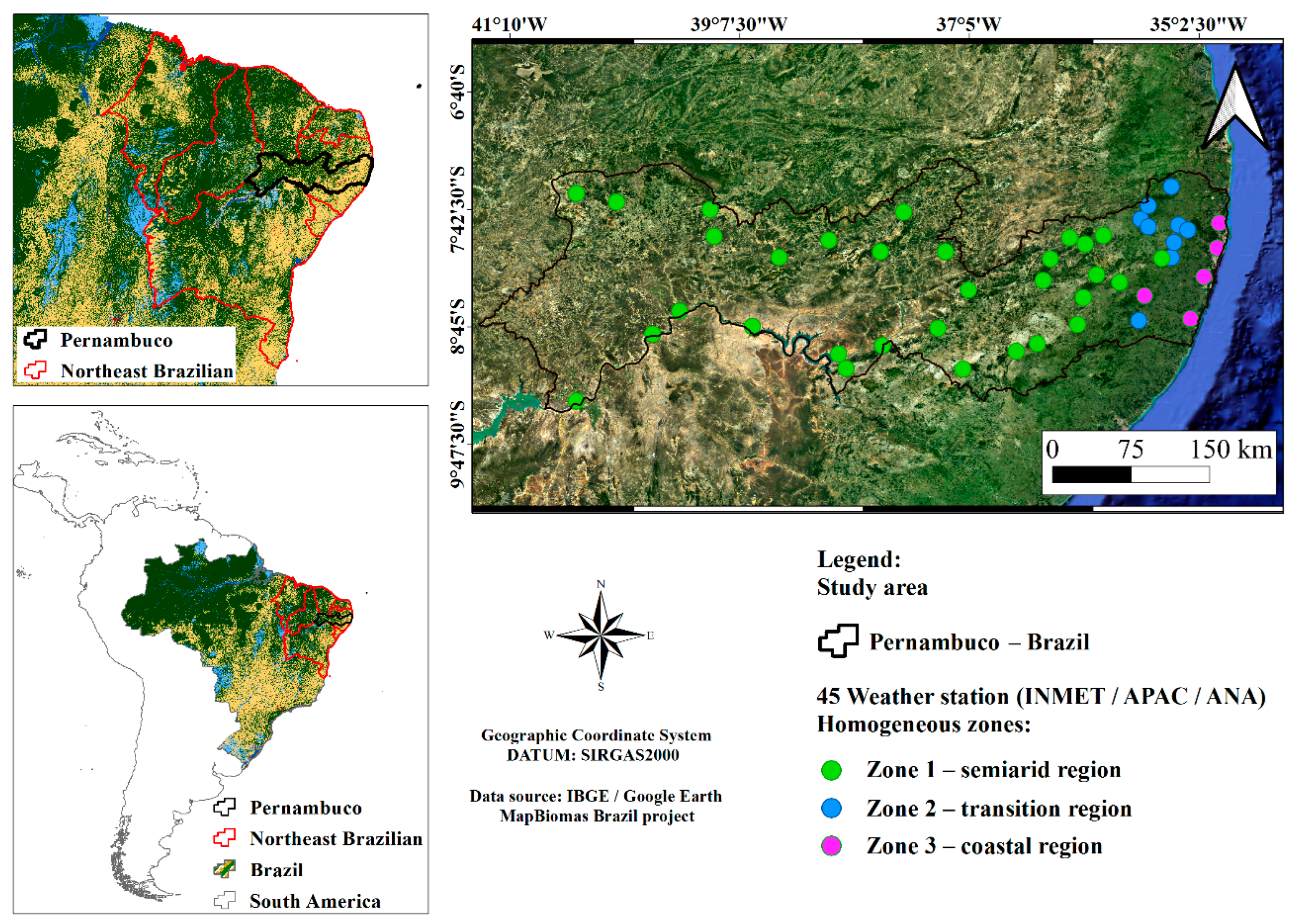
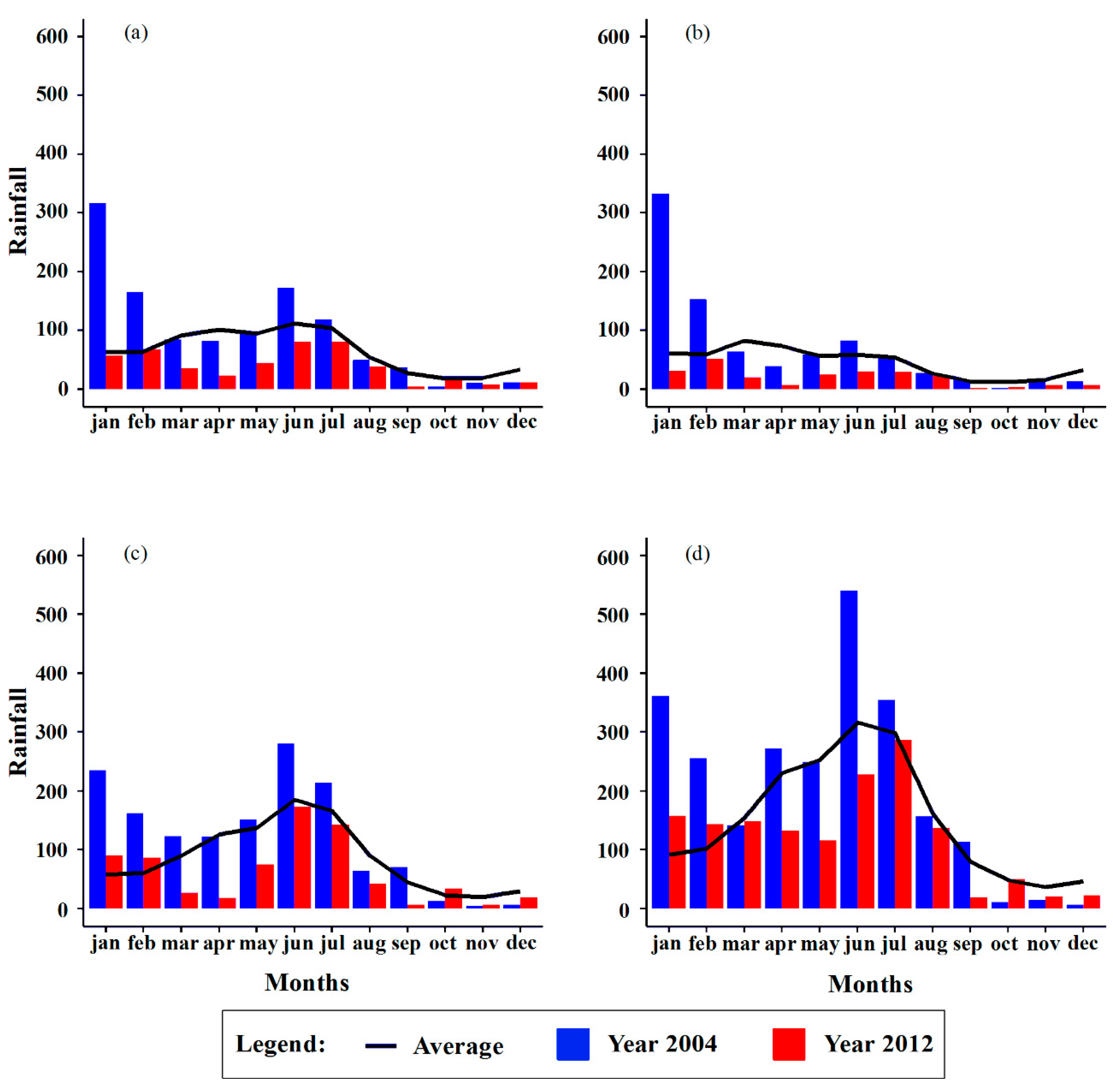
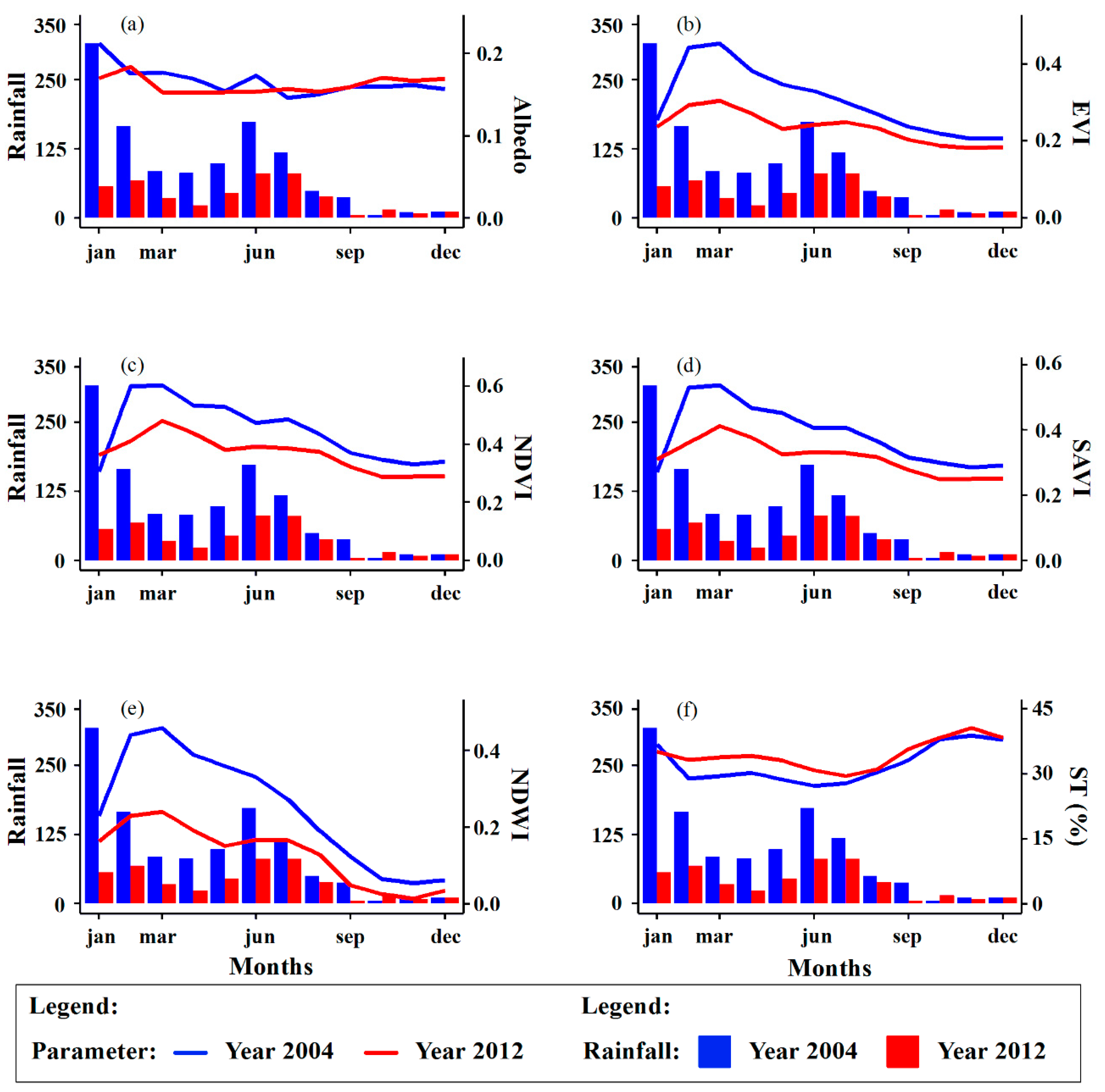

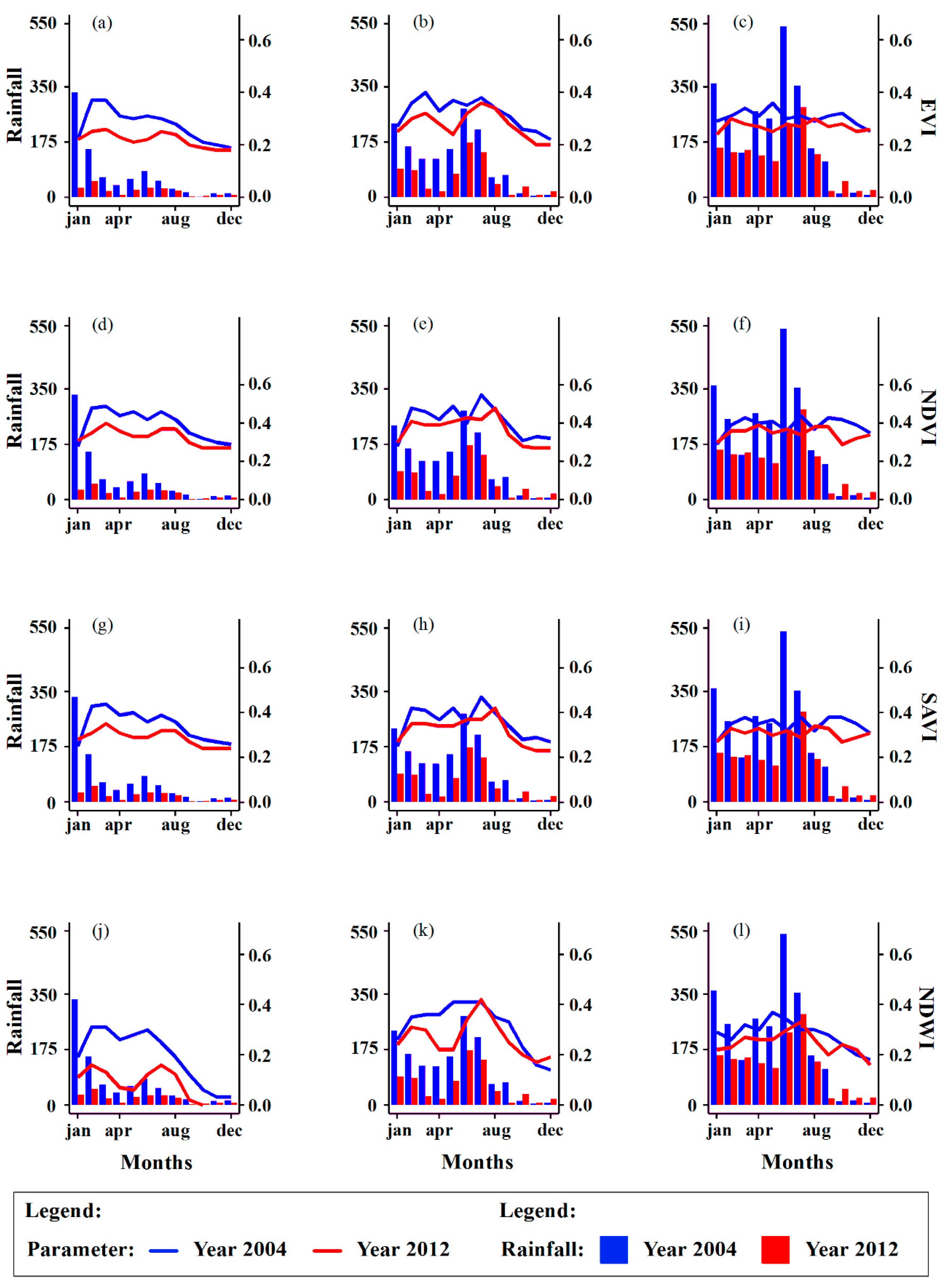
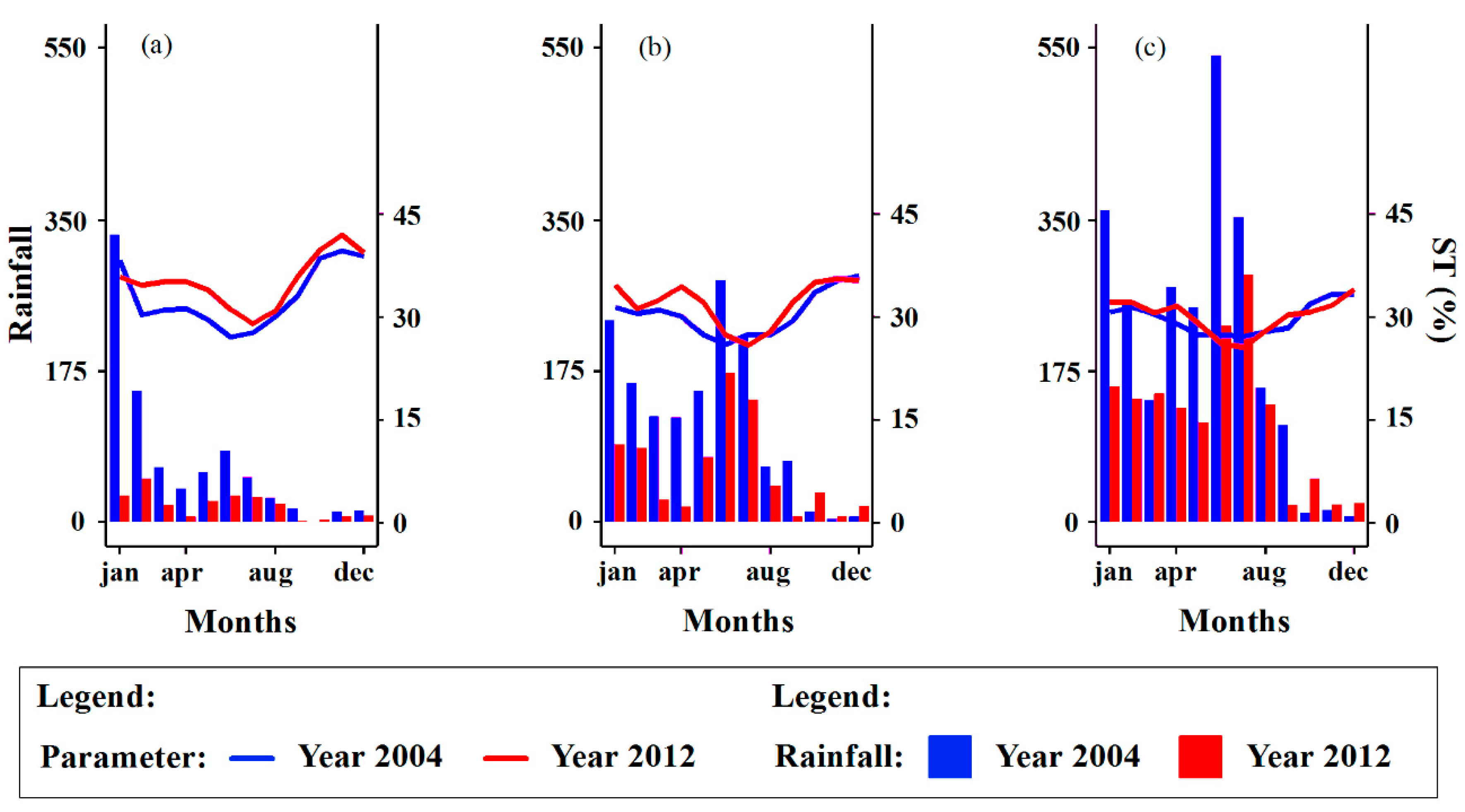
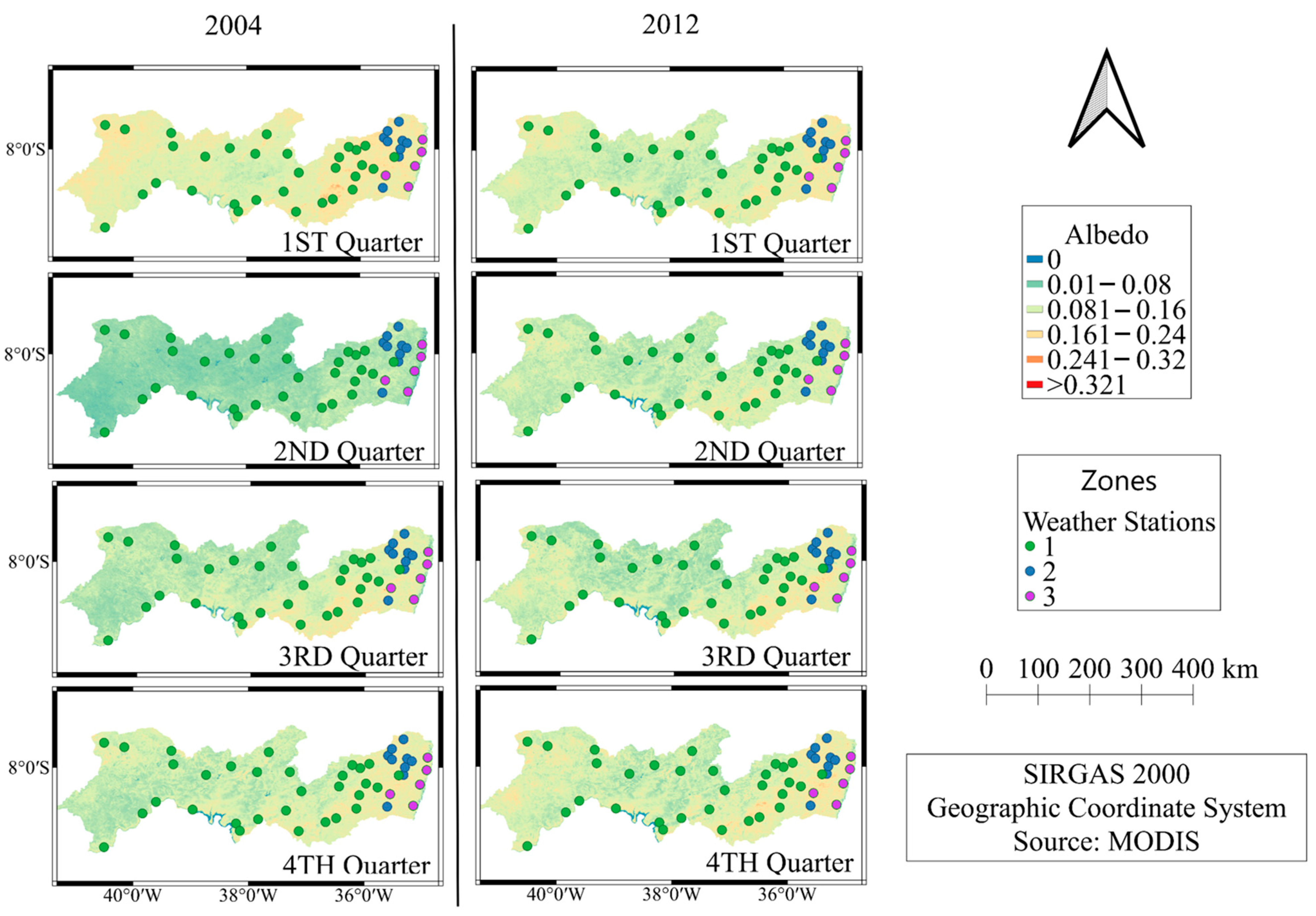
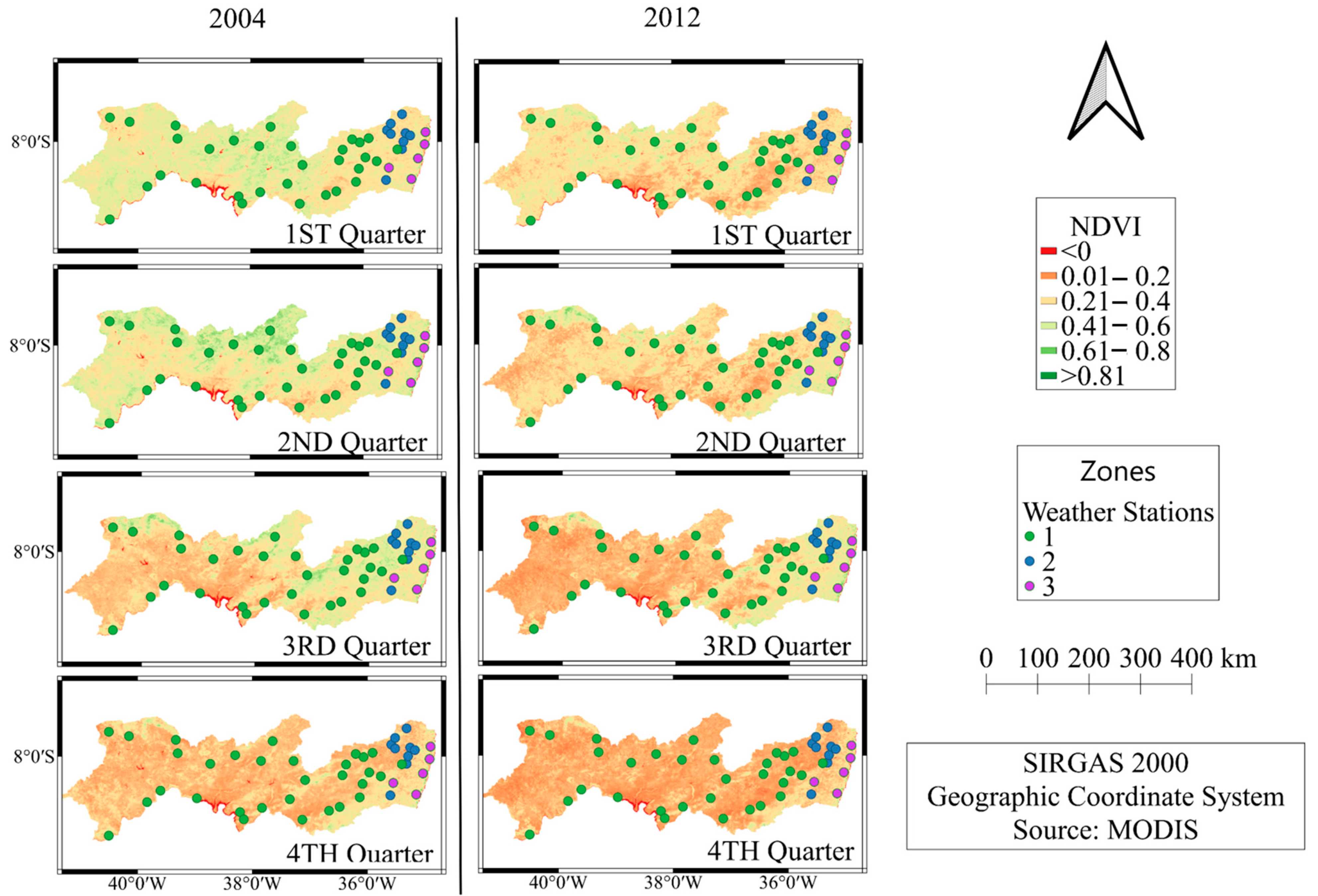

| Biophysical Parameters | Initials | Equations | Author |
|---|---|---|---|
| Surface albedo | α | [38] | |
| Normalized Difference Vegetation Index | NDVI | [39] | |
| Enhanced Vegetation Index | EVI | [40] | |
| Soil-Adjusted Vegetation Index | SAVI | [41] | |
| Normalized Difference Water Index | NDWI | [42] |
| Biophysical Parameter | Correlation | 2004 | 2012 |
|---|---|---|---|
| Albedo | r | 0.27 ns | 0.16 ns |
| Method | Kendall | Pearson | |
| EVI | r | 0.32 ns | 0.54 ns |
| Method | Pearson | Pearson | |
| NDVI | r | 0.12 ns | 0.43 ns |
| Method | Pearson | Pearson | |
| SAVI | r | 0.14 ns | 0.41 ns |
| Method | Pearson | Pearson | |
| NDWI | r | 0.48 ns | 0.69 * |
| Method | Pearson | Pearson | |
| ST | R | −0.28 ns | −0.75 ** |
| Method | Pearson | Pearson |
| Biophysical Parameter | Statistics | 2004 | 2012 | ||||
|---|---|---|---|---|---|---|---|
| Zone 1 | Zone 2 | Zone 3 | Zone 1 | Zone 2 | Zone 3 | ||
| Albedo | R | 0.242 ns | 0.032 ns | 0.478 ns | 0.224 ns | −0.062 ns | 0.061 ns |
| Method | Kendall | Pearson | Pearson | Pearson | Pearson | Pearson | |
| EVI | R | 0.515 * | 0.569 ns | 0.236 ns | 0.675* | 0.511 ns | 0.245 ns |
| Method | Kendall | Pearson | Pearson | Pearson | Pearson | Pearson | |
| NDVI | R | 0.412 ns | 0.355 ns | −0.239 ns | 0.512 ns | 0.468 ns | 0.129 ns |
| Method | Kendall | Pearson | Pearson | Pearson | Pearson | Pearson | |
| SAVI | R | 0.424 ns | 0.373 ns | −0.255 ns | 0.515 ns | 0.461 ns | 0.084 ns |
| Method | Kendall | Pearson | Pearson | Pearson | Pearson | Pearson | |
| NDWI | R | 0.636 ** | 0.699 * | 0.710 ** | 0.829 ** | 0.688 * | 0.842 ** |
| Method | Kendall | Pearson | Pearson | Pearson | Pearson | Pearson | |
| ST | R | −0.424 ns | −0.701 * | −0.662 * | −0.567 ns | −0.708 ** | −0.705 * |
| Method | Kendall | Pearson | Pearson | Pearson | Pearson | Pearson | |
Disclaimer/Publisher’s Note: The statements, opinions and data contained in all publications are solely those of the individual author(s) and contributor(s) and not of MDPI and/or the editor(s). MDPI and/or the editor(s) disclaim responsibility for any injury to people or property resulting from any ideas, methods, instructions or products referred to in the content. |
© 2023 by the authors. Licensee MDPI, Basel, Switzerland. This article is an open access article distributed under the terms and conditions of the Creative Commons Attribution (CC BY) license (https://creativecommons.org/licenses/by/4.0/).
Share and Cite
Bezerra, A.C.; Silva, J.L.B.d.; Silva, D.A.d.O.; Nascimento, C.R.; Ribeiro, E.P.; Galvincio, J.D.; Silva, M.V.d.; Oliveira, H.F.E.d.; Mesquita, M.; Oliveira-Júnior, J.F.d.; et al. Seasonality of Biophysical Parameters in Extreme Years of Precipitation in Pernambuco: Relations, Regionalities, and Variability. Atmosphere 2023, 14, 1712. https://doi.org/10.3390/atmos14121712
Bezerra AC, Silva JLBd, Silva DAdO, Nascimento CR, Ribeiro EP, Galvincio JD, Silva MVd, Oliveira HFEd, Mesquita M, Oliveira-Júnior JFd, et al. Seasonality of Biophysical Parameters in Extreme Years of Precipitation in Pernambuco: Relations, Regionalities, and Variability. Atmosphere. 2023; 14(12):1712. https://doi.org/10.3390/atmos14121712
Chicago/Turabian StyleBezerra, Alan Cézar, Jhon Lennon Bezerra da Silva, Douglas Alberto de Oliveira Silva, Cristina Rodrigues Nascimento, Eberson Pessoa Ribeiro, Josiclêda Domiciano Galvincio, Marcos Vinícius da Silva, Henrique Fonseca Elias de Oliveira, Márcio Mesquita, José Francisco de Oliveira-Júnior, and et al. 2023. "Seasonality of Biophysical Parameters in Extreme Years of Precipitation in Pernambuco: Relations, Regionalities, and Variability" Atmosphere 14, no. 12: 1712. https://doi.org/10.3390/atmos14121712










